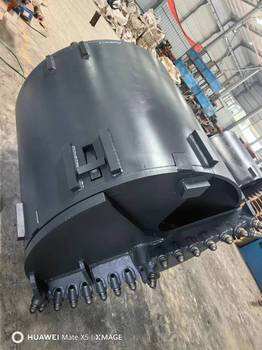পরিচিতি
অজ্ঞদের জন্য, কাদায় পূর্ণ একটি রোটারি ড্রিলিং গর্ত অদ্ভুত মনে হতে পারে – এটি আসলে ড্রিলিং প্রক্রিয়ার একটি আন্তঃস্থলীয় এবং অপরিহার্য অংশ। যা কিছু সঠিক এবং কার্যকরীভাবে ড্রিল করতে সাহায্য করে তাকে রোটারি ড্রিলিংয়ে কাদা বলা হয়। এই নিবন্ধে আমরা (শব্দের খেলা) রোটারি ড্রিলিংয়ের সময় কাদা কী করে, ব্যবহৃত কাদার প্রকার এবং কিভাবে সেগুলি পরিচালনা করা হয় তা নিয়ে আলোচনা করব যাতে ড্রিলিং কর্মক্ষমতার সর্বাধিক সুবিধা পাওয়া যায়।
কাদা কিভাবে কাজ করে ড্রিলিংয়ে? ?
রোটারি ড্রিলিং মাড, বা ড্রিলিং ফ্লুইড রোটারি প্রক্রিয়ায় একটি গুরুত্বপূর্ণ ফ্যাক্টর। এর প্রধান উদ্দেশ্য হল ড্রিল বিটকে লুব্রিকেশন এবং কুল্যান্ট সরবরাহ করা, যা ড্রিলিংয়ের সময় ঘর্ষণ এবং তাপের সঞ্চয় কমায়। এটি ড্রিল বিটের জীবনকাল বাড়ায় এবং অপ্রয়োজনীয় পরিধান ও ছিঁড়ে যাওয়া থেকে ড্রিল স্ট্রিংকে রক্ষা করে।
মাড আরেকটি গুরুত্বপূর্ণ ভূমিকা পালন করে যা হল কাটিংসকে স্থগিত এবং বহন করা। মাটি এবং পাথরের মধ্যে ড্রিল বিটের ঘূর্ণন ছোট কণার সৃষ্টি করে যা কাটিংস নামে পরিচিত। ড্রিলিং মাড কাটিংসকে ফ্লুইডে স্থগিত করে এবং সেগুলোকে গর্তের তলায় বসতে দেয় না, যা একটি কঠিন ড্রিলিং পরিস্থিতি তৈরি করে। মাড কাটিংসকে গর্ত থেকে বের করতে সাহায্য করে এবং ড্রিলিংকে পরিষ্কার রাখে।
রোটারি ড্রিলিংয়ের জন্য ব্যবহৃত মাডের প্রকারগুলি
রোটারি ড্রিলিং বিভিন্ন ধরনের মাটির সাথে সম্পন্ন হয় যা তাদের প্রযুক্তিগত এবং রচনাগত বৈশিষ্ট্য অনুযায়ী প্রস্তুত করা হয়। জল মাটি সবচেয়ে মৌলিক ধরনের, যা শুধুমাত্র জল এবং মাটি একসাথে কিছু বিশেষ রাসায়নিকের সাথে থাকে যা নির্দিষ্ট বৈশিষ্ট্যগুলি উন্নত করতে সাহায্য করে। এটি কিছু ড্রিলিং অ্যাপ্লিকেশনের জন্য সস্তা এবং যথেষ্ট ভালো।
বিপরীতে, তেল ভিত্তিক মাটি আরও জটিল বা উচ্চ চাপের কূপের জন্য সংরক্ষিত। জল ভিত্তিক মাটির তুলনায় এটি আরও ভাল লুব্রিকেশন এবং শীতলকরণ বৈশিষ্ট্য প্রদান করে, এটি উচ্চ চাপের সীমায় পৌঁছায়, যা এটিকে চরম ড্রিলিংয়ের জন্য উপযুক্ত করে তোলে।
ক্ষেত্র বিশেষ্য ভিত্তিতে মাটির ধরনসমূহ হল বেন্টোনাইট স্লারি, যা ছিদ্র বন্ধ করার জন্য এবং ড্রিলিং-এর সময় সর্বোত্তম স্থিতিশীলতা তৈরি করার জন্য অত্যাবশ্যক। এটি ফ্লুইড প্রবাহের মাধ্যমে নির্দেশকের মাধ্যমে ঘূর্ণিঝড়ের ড্রিলিং-এর জন্য বিশেষভাবে উপযোগী, কারণ এটি ছিদ্রের ভিতরে ফ্লুইডের স্থিতিশীল কলাম রखে যা ঘরের সংরক্ষণ বজায় রাখে।
সর্বোত্তম ড্রিলিং কর্মক্ষমতার জন্য মাটি পরিচালনা করা।
খনন কর্মক্ষমতা সর্বাধিক করার জন্য মাটির ঘনত্ব এবং ভিসকোসিটি নিয়ন্ত্রণ করা গুরুত্বপূর্ণ। তরলের ঘনত্ব খনন গভীরতা এবং খনন স্থলের পরিবেশগত ভূতত্ত্বের সাথে সমন্বিত হতে হবে। তবে, মাটির ওজন যথেষ্ট সমন্বিত হতে হবে যাতে কাটিংস ধোয়া যায় এবং গর্তের স্থিতিশীলতা বজায় থাকে।
মাটির বৈশিষ্ট্যগুলি বাস্তব সময়ে পর্যবেক্ষণ এবং সমন্বয় করা উচিত। স্মার্ট মনিটরিং সিস্টেমগুলি মাটির বৈশিষ্ট্যগুলি নিয়ন্ত্রণ করতে পারে যাতে এটি নির্দিষ্ট খনন শর্তগুলির জন্য একটি সর্বোত্তম পরিসরে রাখা হয়। এই সিস্টেমগুলি যে ডেটা সংগ্রহ করে তা খননে প্রবাহিত শক্তি এবং উপ-প্রক্রিয়াগুলি সম্পর্কে অনেক কিছু প্রকাশ করতে পারে, এবং এটি চলমানভাবে সমন্বয় করার অনুমতি দেবে।
মাটির সাথে মোকাবিলা: pitfalls এবং fixes
কাদার ব্যবস্থাপনায় প্রথম বাধাটি খুব প্রাথমিক যা বাধা এবং প্রবাহের সমস্যার দিকে নিয়ে যায়। ফিলিং নোজলগুলি ব্লক হয়ে যেতে পারে, এবং এটি ড্রিল বিটে কাদার প্রবাহ বন্ধ করে দেয়; এই ধরনের অকার্যকারিতা একটি গর্ত খোঁড়ার অনুমতি দেয় না। পাম্প রক্ষণাবেক্ষণ অপরিহার্য, এটি নিয়মিতভাবে তার সঠিক কার্যকারিতা সম্পর্কে পরীক্ষা করতে হবে কারণ অপারেশনের শুরুতে প্রবাহের হার পরিবর্তিত হবে কিন্তু অপারেশন বা ব্যবহারের সময় নয়।
তবে, স্তর সেন্সিং সমস্যাগুলি চিহ্নিত করা সম্পূর্ণ ভিন্ন একটি বিষয়। সঠিক পূরণের স্তর নিশ্চিত করতে স্তর সেন্সরগুলি পরিষ্কার এবং ভাল কাজের অবস্থায় রাখতে হবে। ড্রিলিং গর্তের মধ্যে সঠিক কাদার স্তর বজায় রাখতে সেন্সর কনফিগারেশনগুলি পরিবর্তন করা প্রয়োজন হতে পারে।
কাদা ড্রিলিংয়ের সঠিকতাকে কীভাবে প্রভাবিত করে?
কাদার সবচেয়ে গুরুত্বপূর্ণ কার্যকারিতা হল ড্রিল গর্তকে উল্লম্বভাবে এবং অবস্থানে সমর্থন করা। পাইলিংয়ের জন্য গর্ত খোঁড়ার সময়, যেখানে উচ্চ স্তরের সঠিকতা প্রয়োজন কারণ পার্থক্য একটি গর্ত থেকে বিচ্যুতি সৃষ্টি করতে পারে।
ড্রিলিং সঠিকতা মানব প্রভাবকে পর্যবেক্ষণ ডেটার উপর কমানোর প্রয়োজন। তবে, ঐতিহ্যবাহী পর্যবেক্ষণ প্রযুক্তিগুলি সঠিকতা এবং বাস্তব সময়ের পর্যবেক্ষণ ক্ষমতায় সীমিত হতে পারে। এই প্রক্রিয়ার একমাত্র অসুবিধা হল যে এটি বাস্তব সুবিধাগুলি দেখতে সময় নিতে পারে দুর্বল ভিজ্যুয়ালাইজেশন এবং প্রাথমিক সতর্কতা সিস্টেমের কারণে, তবে এটি ডিজিটাল নির্মাণ সংহত ব্যবস্থাপনা প্ল্যাটফর্মের অগ্রগতির কারণে উন্নত হয়েছে যা ড্রিলিংয়ের আরও সঠিক নিয়ন্ত্রণের অনুমতি দেয়।
উপসংহার
রোটারি ড্রিলিংয়ের সময় গর্তে কাদা থাকা খারাপ অভ্যাস নয়; এটি একটি প্রয়োজনীয় উপাদান। ড্রিলিং কাদা একটি তরল যা আপনার বিটকে সমর্থন করা, এটি ঠান্ডা করা, কাটিংসকে পৃষ্ঠে নিয়ে যাওয়া এবং আপনার ড্রিলিং গর্তের স্থিতিশীলতা বজায় রাখার কাজ করে। ড্রিলিং কাদা — কাদা হল ড্রিল প্রক্রিয়ার সবচেয়ে গুরুত্বপূর্ণ দিকগুলির মধ্যে একটি। কূপ খননের ক্ষমতা বাড়ানোর সাথে সাথে — এই বিশেষ রোটারি ড্রিলিং পদ্ধতির অংশ পরিচালনার জন্য প্রয়োজনীয় অনুশীলনও বাড়বে।

